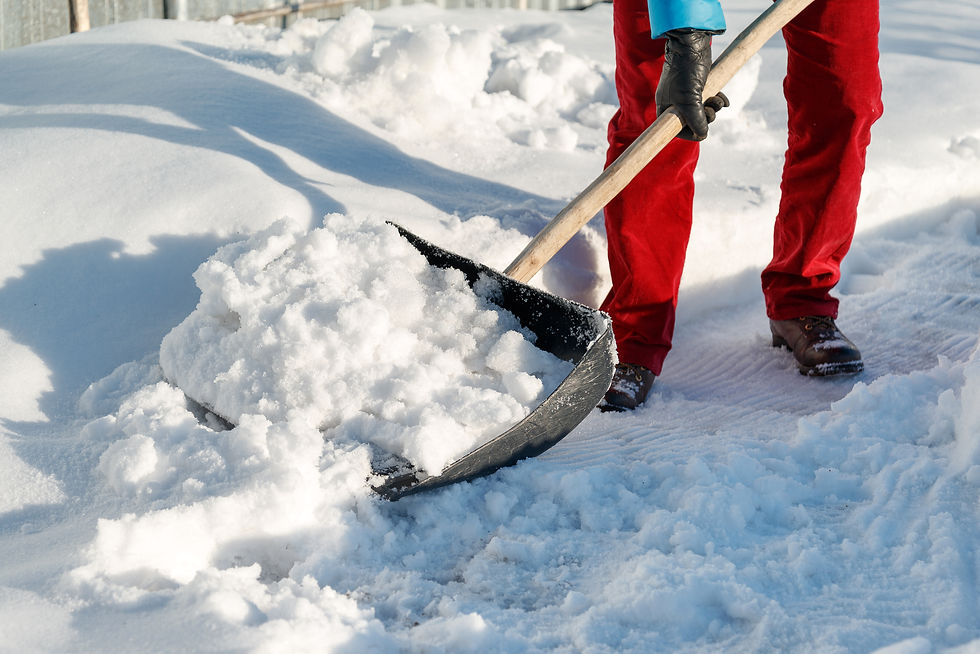Essential Stretches to Prevent Back Injuries While Shoveling Snow This Winter
- Wendy Whitehead

- Nov 4
- 3 min read
As winter approaches, many of us are gearing up for the inevitable task of shoveling snow. While it may seem like a routine chore, shoveling can lead to serious back injuries if it is not done correctly. Cold weather and heavy snowfall can strain your body, particularly your back. To help you stay safe and injury-free this winter, we’ve compiled a list of essential stretches to perform before you grab that shovel.
Before we jump into the stretches, it's crucial to understand the risks associated with shoveling snow. According to the American Academy of Orthopaedic Surgeons, over 30,000 people are injured every year while shoveling snow. The repetitive motion and heavy lifting can lead to muscle strains, sprains, and even more severe injuries. Incorporating a few simple stretches into your routine can effectively prepare your body for the challenges of snow removal.

The Importance of Warming Up
Warming up your muscles before any physical activity is crucial, especially when it comes to shoveling snow. A proper warm-up increases blood flow to your muscles, enhances flexibility, and reduces the risk of injury.
Take a few minutes to engage in light aerobic activity, such as marching in place or walking around your home. This will elevate your heart rate and prepare your body for the task ahead. A quick 5-minute warm-up can be a game-changer, reducing injury risk by nearly 50%.
Essential Stretches to Perform
1. Neck Stretch
Begin by gently tilting your head to one side, bringing your ear toward your shoulder. Hold this position for 15-30 seconds, feeling the stretch along the side of your neck. Switch sides and repeat.
This stretch alleviates tension in your neck, which often tightens during shoveling sessions.
2. Shoulder Rolls
Stand or sit up straight and roll your shoulders forward in a circular motion for 10 repetitions. Then, reverse the direction and roll your shoulders backward for another 10 repetitions.
Shoulder rolls help loosen the shoulder muscles, reducing tightness that can come from shoveling.
3. Torso Twist
Stand with your feet shoulder-width apart. Place your hands on your hips and gently twist your torso to the right, holding for 15-30 seconds before returning to the center. Repeat on the left side.
This stretch improves spinal mobility and gets your back ready for the twisting motions involved in snow shoveling.
4. Hamstring Stretch
While standing, place one foot on a low surface, such as a step or a sturdy chair. Keep your leg straight and lean forward slightly, feeling the stretch in the back of your thigh. Hold for 15-30 seconds and switch legs.
Stretching your hamstrings can significantly reduce tension in your lower back. Studies show that a flexible hamstring can reduce lower back pain by up to 40%.
5. Quadriceps Stretch
Stand on one leg and grab your opposite ankle, pulling it toward your glutes. Keep your knees close together and hold for 15-30 seconds. Switch legs.
This stretch targets the quadriceps, a group of muscles that can tighten from strong movements like lifting snow.

6. Lower Back Stretch
Lie on your back with your knees bent and feet flat on the floor. Gently bring your knees to your chest, holding for 15-30 seconds. This stretch releases tension in your lower back.
7. Cat-Cow Stretch
Get on your hands and knees in a tabletop position. Inhale as you arch your back (cow position) and exhale as you round your back (cat position). Repeat this sequence for 5-10 breaths.
The cat-cow stretch is a great way to enhance flexibility in your spine and warm up your back muscles.
8. Side Stretch
Stand with your feet shoulder-width apart. Raise one arm overhead and lean to the opposite side, feeling the stretch along your side. Hold for 15-30 seconds and switch sides.
This stretch can alleviate tension in your back and open up your sides, which is helpful when lifting snow.
Tips for Safe Shoveling
Beyond stretching, consider these tips to ensure safety while shoveling snow:
Use the right shovel: A lightweight shovel with a curved handle minimizes stress on your back and makes lifting easier.
Lift with your legs: Always bend at your knees and keep your back straight when lifting snow. Avoid twisting your body while lifting to prevent injury.
Final Thoughts
As winter sets in and snow begins to fall, it's essential to take precautions to protect your back while shoveling. By incorporating these essential stretches into your routine, you can prepare your body for the physical demands of snow removal and significantly reduce your risk of injury.
Make sure to warm up, use proper techniques, and listen to your body. If you feel any pain or discomfort while shoveling, stop immediately and consult a healthcare professional. Stay safe and enjoy the winter season!






Comments